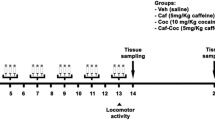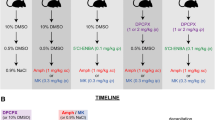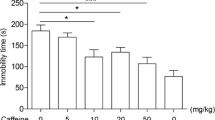Abstract
Aripiprazole is an antipsychotic that acts as a partial agonist at dopamine D2 receptors. In addition to its antipsychotic activity, this compound blocks the effects of some psychostimulant drugs. It has not been verified, however, if aripiprazole interferes with the effects of caffeine. Hence, this study tested the hypothesis that aripiprazole prevents caffeine-induced hyperlocomotion and investigated the effects of these drugs on neural activity in the striatum. Male Swiss mice received injections of vehicle or antipsychotic drugs followed by vehicle or caffeine. Locomotion was analyzed in a circular arena and c-Fos protein expression was quantified in the dorsolateral, dorsomedial, and ventrolateral striatum, and in the core and shell regions of nucleus accumbens. Aripiprazole (0.1, 1, and 10 mg/kg) prevented caffeine (10 mg/kg)-induced hyperlocomotion at doses that do not change basal locomotion. Haloperidol (0.01, 0.03, and 0.1 mg/kg) also decreased caffeine-induced hyperlocomotion at all doses, although at the two higher doses, this compound reduced basal locomotion. Immunohistochemistry analysis showed that aripiprazole increases c-Fos protein expression in all regions studied, whereas caffeine did not alter c-Fos protein expression. Combined treatment of aripiprazole and caffeine resulted in a decrease in the number of c-Fos positive cells as compared to the group receiving aripiprazole alone. In conclusion, aripiprazole prevents caffeine-induced hyperlocomotion and increases neural activation in the striatum. This latter effect is reduced by subsequent administration of caffeine. These results advance our understanding on the pharmacological profile of aripiprazole.





Similar content being viewed by others
References
Abekawa T, Ito K, Nakagawa S, Nakato Y, Koyama T (2011) Effects of aripiprazole and haloperidol on progression to schizophrenia-like behavioural abnormalities and apoptosis in rodents. Schizophr Res 125:77–87
Almeida-Santos AF, Gobira PH, Souza DP, Ferreira RC, Romero TR, Duarte ID, Aguiar DC, Moreira FA (2014) The antipsychotic aripiprazole selectively prevents the stimulant and rewarding effects of morphine in mice. Eur J Pharmacol 742:139–144
Beijamini V, Guimarães FS (2006) c-Fos expression increase in NADPH-diaphorase positive neurons after exposure to a live cat. Behav Brain Res 170:52–61
Bennett HJ, Semba K (1998) Immunohistochemical localization of caffeine-induced c-Fos protein expression in the rat brain. J Comp Neurol 401:89–108
Bergman J (2008) Medications for stimulant abuse: agonist-based strategies and preclinical evaluation of the mixed-action D2 partial agonist aripiprazole (Abilify). Exp Clin Psychopharm 16:475–483
Boettger S, Jenewein J, Breitbart W (2014) Haloperidol, risperidone, olanzapine and aripiprazole in the management of delirium: a comparison of efficacy, safety, and side effects. Palliat Support Care 13:1079–1085
Carey RJ, De Palma G, Damianopoulos E (2002) 5-HT1A agonist/antagonist modification of cocaine stimulant effects: implications for cocaine mechanisms. Behav Brain Res 132:37–46
Daly JW, Fredholm BB (1998) Caffeine—an atypical drug of dependence. Drug Alcohol Depen 51:199–206
De Luca MA, Bassareo V, Bauer A, Di Chiara G (2007) Caffeine and accumbens shell dopamine. J Neurochem 103:157–163
Dubroqua S, Yee BK, Singer P (2014) Sensorimotor gating is disrupted by acute but not chronic systemic exposure to caffeine in mice. Psychopharmacology 231:4087–4098
El Yacoubi M, Ledent C, Menard JF, Parmentier M, Costentin J, Vaugeois JM (2000) The stimulant effects of caffeine on locomotor behaviour in mice are mediated through its blockade of adenosine A2A receptors. Brit J Pharmacol 129:1465–1473
Estler CJ (1973) Effect of alfa- and beta-adrenergic blocking agents and para-chlorophenylalanine on morphine and caffeine-stimulated locomotor activity of mice. Psychopharmacologia 28:261–268
Ferre S (2008) An update on the mechanisms of the psychostimulant effects of caffeine. J Neurochem 105:1067–1079
Ferre S, Fredholm BB, Morelli M, Popoli P, Fuxe K (1997) Adenosine-dopamine receptor-receptor interactions as an integrative mechanism in the basal ganglia. Trends Neurosci 20:482–487
Garrett BE, Holtzman SG (1994) D1 and D2 dopamine receptor antagonists block caffeine-induced stimulation of locomotor activity in rats. Pharmacol Biochem Be 47:89–94
Gobira PH, Ropke J, Aguiar DC, Crippa JA, Moreira FA (2013) Animal models for predicting the efficacy and side effects of antipsychotic drugs. Rev Bras Psiquiatr 35(Suppl 2):S132–S139
Jerlhag E (2008) The antipsychotic aripiprazole antagonizes the ethanol- and amphetamine-induced locomotor stimulation in mice. Alcohol 42:123–127
Kikuchi T, Tottori K, Uwahodo Y, Hirose T, Miwa T, Oshiro Y, Morita S (1995) 7-(4-[4-(2,3-Dichlorophenyl)-1-piperazinyl]butyloxy)-3,4-dihydro-2(1H)-quinolinon e (OPC-14597), a new putative antipsychotic drug with both presynaptic dopamine autoreceptor agonistic activity and postsynaptic D2 receptor antagonistic activity. J Pharmacol Exp Ther 274:329–336
Konradi C, Heckers S (1995) Haloperidol-induced Fos expression in striatum is dependent upon transcription factor cyclic AMP response element binding protein. Neuroscience 65:1051–1061
Leite JV, Guimaraes FS, Moreira FA (2008) Aripiprazole, an atypical antipsychotic, prevents the motor hyperactivity induced by psychotomimetics and psychostimulants in mice. Eur J Pharmacol 578:222–227
Lopez-Cruz L, Pardo M, Salamone JD, Correa M (2014) Differences between the nonselective adenosine receptor antagonists caffeine and theophylline in motor and mood effects: Studies using medium to high doses in animal models. Behav Brain Res 270:213–222
Mailman RB, Murthy V (2010) Third generation antipsychotic drugs: partial agonism or receptor functional selectivity? Curr Pharm Design 16:488–501
Marinho EA, Oliveira-Lima AJ, Wuo-Silva R, Santos R, Baldaia MA, Hollais AW, Longo BM, Berro LF, Frussa-Filho R (2014) Selective action of an atypical neuroleptic on the mechanisms related to the development of cocaine addiction: a pre-clinical behavioural study. Int J Neuropsychopharmacol 17:613–623
Moreira FA, Dalley JW (2015) Dopamine receptor partial agonists and addiction. Eur J Pharmacol 752:112–115
Nakai S, Hirose T, Uwahodo Y, Imaoka T, Okazaki H, Miwa T, Nakai M, Yamada S, Dunn B, Burris KD, Molinoff PB, Tottori K, Altar CA, Kikuchi T (2003) Diminished catalepsy and dopamine metabolism distinguish aripiprazole from haloperidol or risperidone. Eur J Pharmacol 472:89–97
Natesan S, Reckless GE, Nobrega JN, Fletcher PJ, Kapur S (2006) Dissociation between in vivo occupancy and functional antagonism of dopamine D2 receptors: comparing aripiprazole to other antipsychotics in animal models. Neuropsychopharmacology 31:1854–1863
Natesan S, Reckless GE, Barlow KB, Nobrega JN, Kapur S (2011) Partial agonists in schizophrenia—why some work and others do not: insights from preclinical animal models. Int J Neuropsychopharmacol 14:1165–1178
Oka T, Hamamura T, Lee Y, Miyata S, Habara T, Endo S, Taoka H, Kuroda S (2004) Atypical properties of several classes of antipsychotic drugs on the basis of differential induction of Fos-like immunoreactivity in the rat brain. Life Sci 76:225–237
Paxinos G, Franklin KBJ (2012) The mouse brain in stereotaxic coordinates. Academic Press, San Diego
Pollack AE, Fink JS (1995) Adenosine antagonists potentiate D2 dopamine-dependent activation of Fos in the striatopallidal pathway. Neuroscience 68:721–728
Quarta D, Ferré S, Solinas M, You Z-B, Hockemeyer J, Popoli P, Goldberg SR (2004) Opposite modulatory roles for adenosine A1 and A2A receptors on glutamate and dopamine release in the shell of the nucleus accumbens. Effects of chronic caffeine exposure. J Neurochem 88:1151–1158
Robertson GS, Fibiger HC (1992) Neuroleptics increase c-Fos expression in the forebrain: contrasting effects of haloperidol and clozapine. Neuroscience 46:315–328
Shapiro DA, Renock S, Arrington E, Chiodo LA, Liu LX, Sibley DR, Roth BL, Mailman R (2003) Aripiprazole, a novel atypical antipsychotic drug with a unique and robust pharmacology. Neuropsychopharmacology 28:1400–1411
Steeds H, Carhart-Harris RL, Stone JM (2015) Drug models of schizophrenia. Ther Adv Psychopharmacol 5:43–58
Stip E, Tourjman V (2010) Aripiprazole in schizophrenia and schizoaffective disorder: a review. Clin Ther 32(Suppl 1):S3–S20
Svenningsson P, Strom A, Johansson B, Fredholm BB (1995) Increased expression of c-jun, junB, AP-1, and preproenkephalin mRNA in rat striatum following a single injection of caffeine. J Neurosci 3583–3593
Viana TG, Almeida-Santos AF, Aguiar DC, Moreira FA (2013) Effects of aripiprazole, an atypical antipsychotic, on the motor alterations induced by acute ethanol administration in mice. Basic Clin Pharmacol Toxicol 112:319–324
Wen XJ, Wang LM, Liu ZL, Huang A, Liu YY, Hu JY (2014) Meta-analysis on the efficacy and tolerability of the augmentation of antidepressants with atypical antipsychotics in patients with major depressive disorder. Braz J Med Biol Res 47:605–616
Zhang Q, Yu YP, Ye YL, Zhang JT, Zhang WP, Wei EQ (2011) Spatiotemporal properties of locomotor activity after administration of central nervous stimulants and sedatives in mice. Pharmacol Biochem Be 97:577–585
Acknowledgments
The authors thank the financial support from FAPEMIG (APQ-01728-13).
FAM is a recipient of a CNPq productivity fellowship (level 2). The authors declare that they have no conflict of interest
Author information
Authors and Affiliations
Corresponding author
Rights and permissions
About this article
Cite this article
Batista, L.A., Viana, T.G., Silveira, V.T. et al. Effects of aripiprazole on caffeine-induced hyperlocomotion and neural activation in the striatum. Naunyn-Schmiedeberg's Arch Pharmacol 389, 11–16 (2016). https://doi.org/10.1007/s00210-015-1170-x
Received:
Accepted:
Published:
Issue Date:
DOI: https://doi.org/10.1007/s00210-015-1170-x




